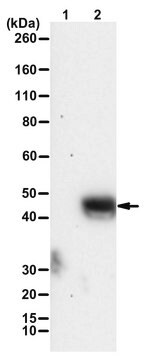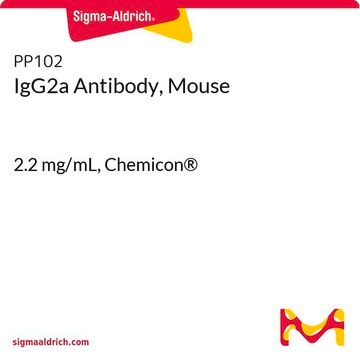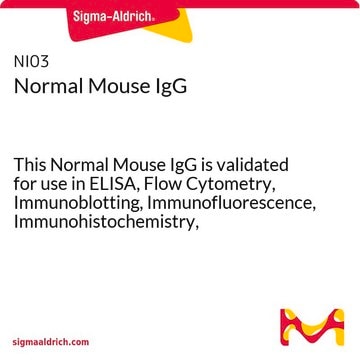一般說明
We are committed to bringing you greener alternative products, which adhere to one or more of The 12 Principles of Green Chemistry.This antibody is Preservative-free, produced without the harm or sacrifice of animals and exceptionally stable to allow for ambient shipping and storage if needed and thus aligns with "Waste Prevention", "Designing Safer Chemicals" and "Design for Energy Efficiency".
Click here for more information.
ZooMAb® antibodies represent an entirely new generation of recombinant monoclonal antibodies.
Each ZooMAb® antibody is manufactured using our proprietary recombinant expression system, purified to homogeneity, and precisely dispensed to produce robust and highly reproducible lot-to-lot consistency. Only top-performing clones are released for use by researchers. Each antibody is validated for high specificity and affinity across multiple applications, including its most commonly used application. ZooMAb® antibodies are reliably available and ready to ship when you need them.
特異性
Clone 1E17 is a ZooMAb® Rabbit recombinant monoclonal antibody that specifically detects ULK1 phosphorylated on serine 555.
免疫原
KLH-conjugated linear peptide corresponding to 10 amino acids surrounding phosphoserine 555 of human ULK1.
應用
Quality Control Testing
Evaluated by Western Blotting in MCF7 cells, overnight starved and treated with oligomycin.
Western Blotting Analysis: A 1:1,000 dilution from a representative lot detected phospho-ULK1-Ser555 in MCF7 cells serum starved overnight and treated with Oligomycin (0.5 mM)
Tested applications
Peptide Inhibition Assay: Target band detection in lysates from MCF7 cells, serum starved and treated with oligomycin (0.5 mM), was prevented by preblocking of a representative lot with the immunogen phosphopeptide, but not the corresponding non-phosphopeptide.
Immunocytochemistry Analysis (ICC): A 1:100 dilution of this antibody detected phospho-ULK1-Ser555 in serum starved MCF7 cells.
Affinity Binding Assay: A representative lot of this antibody bound phospho-ULK1-Ser555 with a KD of 1.1 x 10-7 in an affinity binding assay.
Note: Actual optimal working dilutions must be determined by end user as specimens, and experimental conditions may vary with the end user
標靶描述
Serine/threonine-protein kinase ULK1 (UniProt: O75385; also known as EC:2.7.11.1, Autophagy-related protein 1 homolog, ATG1, hATG1, Unc-51-like kinase 1) is encoded by the ULK1 (also known as KIAA0722) gene (Gene ID: 8408) in human. ULK1 is a ubiquitously expressed serine-threonine protein kinase that is involved in autophagy in response to starvation. During starvation it is localized to puncate structures primarily representing the isolation membrane that sequesters a portion of the cytoplasm resulting in the formation of an autophagosome. In cells, ULK1 is constitutively expressed in complex with at least three proteins: ATG13, FIP200 and ATG101. Interaction of ULK1 with ATG13 or FIP200 is reported to increase ULK1 kinase activity and stability. ULK1 undergoes autophosphorylation under nutrient-rich conditions and is dephosphorylated during starvation or following treatment with rapamycin. Under nutrient sufficiency, it is phosphorylated by MTOR/mTOR, which disrupts the interaction with AMPK and prevents activation of ULK1. In response to nutrient limitation, it is phosphorylated and activated by AMPK that leads to activation of autophagy. Phosphorylation at Ser555 by AMPK is reported to be critical for starvation-induced autophagy and for cell survival under conditions of low nutrients and energy. ULK1 can also act as a regulator of AMPK by mediating phosphorylation of AMPK subunits PRKAA1, PRKAB2 and PRKAG1, leading to negative regulation of AMPK activity. Under nutrient sufficiency, high mTOR activity is reported to prevent ULK1 activation by phosphorylating ULK1 and disrupt its interaction with AMPK. The protein kinase domain of ULK1 is localized to amino acids 16-278. This ZooMAb® recombinant monoclonal antibody, generated by our propriety technology, offers significantly enhanced specificity, affinity, reproducibility, and stability over conventional monoclonals. (Ref.: Zachari, M., and Ganley, IG. (2017). Essays Biochem. 61(6); 585-596; Kim, J., et al. (2011). Nat. Cell Biol. 13(2); 132-141; Egan, DF., et al. (2011). Science. 331(6016). 456-461).
外觀
Purified recombinant rabbit monoclonal antibody IgG, lyophilized in PBS with 5% Trehalose, normal appearance a coarse or translucent resin. The PBS/trehalose components in the ZooMAb formulation can have the appearance of a semi-solid (bead like gel) after lyophilization. This is a normal phenomenon. Please follow the recommended reconstitution procedure in the data sheet to dissolve the semi-solid, bead-like, gel-appearing material. The resulting antibody solution is completely stable and functional as proven by full functional testing. Contains no biocide or preservatives, such as azide, or any animal by-products. Larger pack sizes provided as multiples of 25 μL.
重構
300 μg/mL after reconstitution at 25 μL per vial. Please refer to guidance on suggested starting dilutions and/or titers per application and sample type.
儲存和穩定性
Recommend storage of lyophilized product at 2-8°C; Before reconstitution, micro-centrifuge vials briefly to spin down material to bottom of the vial; Reconstitute each vial by adding 25 μL of filtered lab grade water or PBS; Reconstituted antibodies can be stored at 2-8°C, or -20°C for long term storage. Avoid repeated freeze-thaws.
法律資訊
ZooMAb is a registered trademark of Merck KGaA, Darmstadt, Germany
免責聲明
Unless otherwise stated in our catalog or other company documentation accompanying the product(s), our products are intended for research use only and are not to be used for any other purpose, which includes but is not limited to, unauthorized commercial uses, in vitro diagnostic uses, ex vivo or in vivo therapeutic uses or any type of consumption or application to humans or animals.










